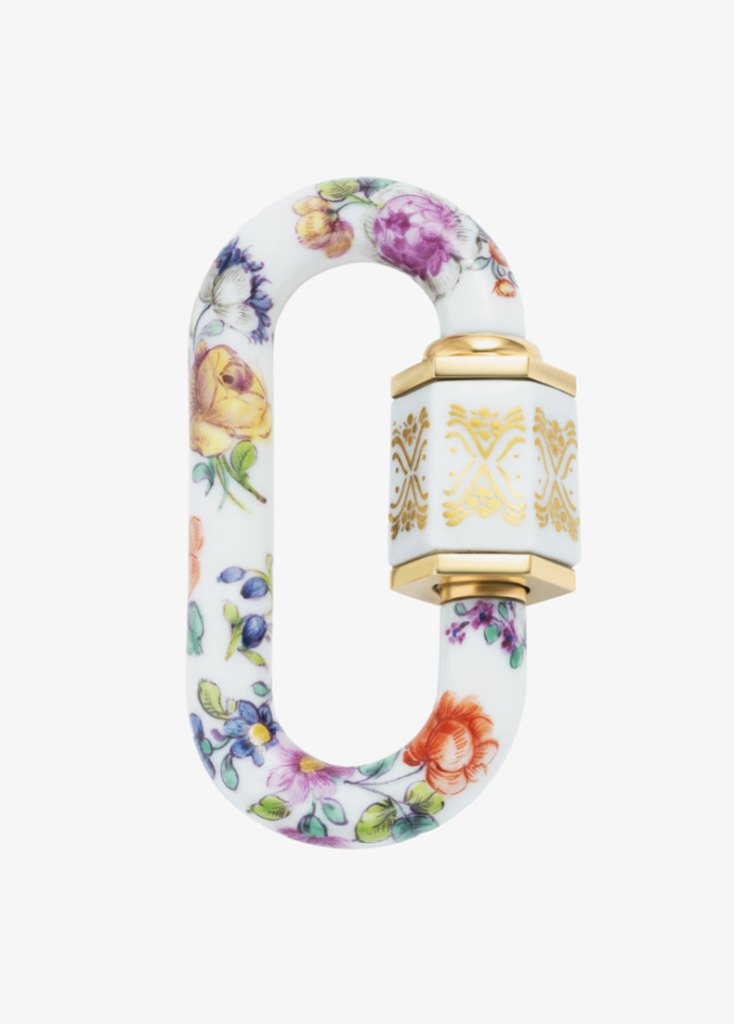From the October 2025 issue of Apollo. Preview and subscribe here.
Marla Aaron has a knack for stopping people in their tracks. She made her debut in the jewellery world in 2012 with an oversized, utilitarian carabiner, or ‘lock’, that became the cornerstone of a new concept: modular jewellery. The piece can be worn as a pendant necklace, linked into a chain or coiled around the wrist. She expanded on the idea with a novel hinged ring that could also integrate chains and bracelets. Her tagline of ‘hard-working jewellery’ is fitting.
In 2016 Aaron installed a jewellery vending machine at the Brooklyn Museum; a second followed in a hotel garden in Brooklyn and a third at the Rockefeller Center. In 2022 she took the concept to new heights with a gumball machine dispensing jewels at Bergdorf Goodman. And yet, even for a designer known for eccentricity, her latest move caught everyone off guard: a collaboration with Porzellan Manufaktur Nymphenburg, the 278-year-old purveyor of fine porcelain to the Bavarian royal court.
‘I had been circling this idea for years,’ Aaron says. ‘I first met someone from Nymphenburg when I was still a marketing executive – before I had even launched the jewellery. Hearing him talk about the history of the company and the way Nymphenburg works, it stayed with me.’
Her fascination grew so strong that in 2017 – five years after starting her eponymous brand – she invited Anders Thomas, Nymphenburg CEO, and Ingrid Harding, head of product development, to her studio ‘with some very vague notions of what we could do together’. More brainstorming followed until, in 2022, Aaron finally visited the baroque Nymphenburg Palace in Munich, where the manufactury is housed.
‘I couldn’t get it out of my mind,’ she says. ‘When I visited, I watched the artisans work, toured the archives and was even served lunch. The food was offered on such exquisite porcelain that I offered to do the dishes just for the pleasure of holding them. That’s when it struck me: the porcelain could be an “object”, but it could also be jewellery.’
From there, the idea was very simple: to celebrate the artistry of Nymphenburg through Aaron’s functional, mechanism-driven designs, bringing this rare and endangered craft to a broader audience. Putting it into practice, however, was anything but.
Aaron had her heart set on working with the Cumberland pattern – a lavish rococo floral motif featuring bouquets, butterflies and insects, all edged with fine 18-carat gold. The motif was designed in the 1760s by Joseph Zächenberger for the Earl of Cumberland and it remains one of the most intricate hand-painted decorations still produced today. Only artisans with a decade or more of experience are allowed to paint it.

‘Jewellery is not our area of expertise, and we are usually hesitant about collaborations,’ Harding says. ‘But Marla’s energy and enthusiasm captivated us so much that we were happy to do the development work with her and release our historic Cumberland decor.’
Nymphenburg has, in the past, worked with artists and designers such as Damien Hirst and Vivienne Westwood. However, adapting the Cumberland pattern for jewellery required selected expert artisans to scale it down and work with even greater precision, ensuring its character remained intact when miniaturised. Once painted, the tiny, fragile porcelain pieces were shipped to New York’s Diamond District, where Aaron’s team painstakingly assembled them into functional jewels – ones that could open, close and hold charms – while remaining intact and easy to handle.
‘I’m often told that my ideas are impossible, but porcelain added a whole new level of “crazy”,’ Aaron says. ‘We tested, retested, started again, until it finally worked.’
One of the biggest engineering challenges was perfecting the threading of her signature lock so that it would open and close smoothly while holding the porcelain securely. Similarly, the earring discs had to be refined until they were light enough to wear but thick enough to display the hand-painted patterns clearly. ‘Some pieces broke along the way – I kept trays of them in my office to tell the story of how we got here,’ Aaron says.
The result is a capsule collection debuting in October. It includes Aaron’s lock, now reimagined with Nymphenburg porcelain; a bracelet with a rolling cylinder clasp; a disc that can be worn as either an earring or a pendant; and what Aaron calls the ‘depository’: a small, vase-like stand about 15cm tall with an 8cm base, meant to hold rings, coins or even a single flower. The form was inspired by a desk accessory Aaron inherited from her grandfather. Prices start at $800 for an unpainted porcelain depository and climb to $16,000 for the fully decorated, oversized lock.
‘Our jewellery has always been about function and play – mechanisms, things that open, close and transform,’ Aaron says. ‘When I saw Nymphenburg’s rococo Cumberland pattern, I knew immediately: the juxtaposition of that delicate, centuries-old artistry with our functional jewellery would be startlingly beautiful – if we could pull it off.’
From the October 2025 issue of Apollo. Preview and subscribe here.